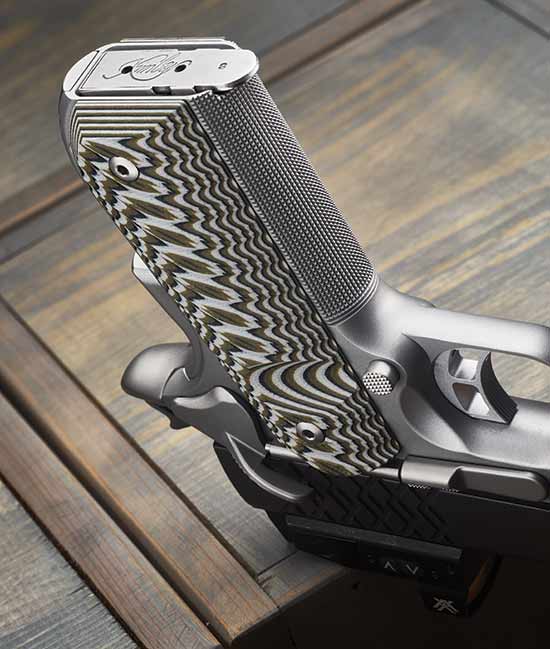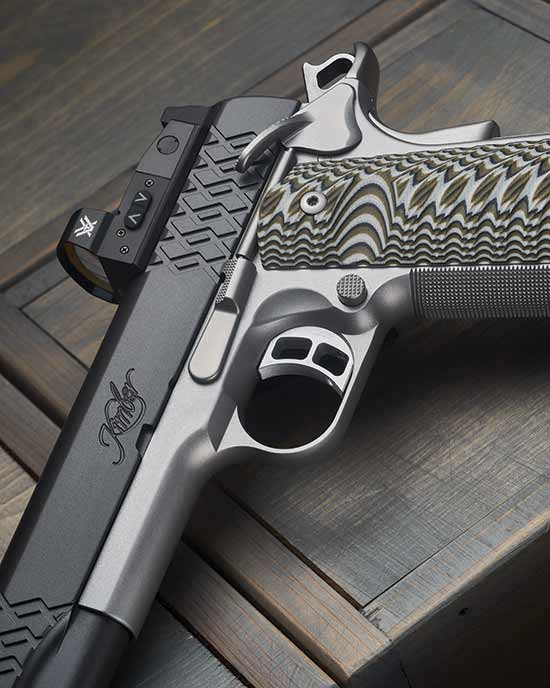Aegis Elite Pro 9mm Vortex Venom
The ageless 1911 marches on, even managing to stay on top of newly emerging trends as it goes. Case in point: The Kimber Aegis Elite Pro, coming direct from the factory with a “carry optic” sight.
We shouldn’t be surprised: the 1911 was among the first pistols to get red dot optics, first in the bull’s eye competition world, and then in NRA Action Pistol and thereafter in USPSA. These, however, were the big bulky tubes of old, unsuitable for daily holster carry. Today’s smaller carry optics are becoming a trend in the CCW world. Though seen mostly on modern polymer pistols, our test gun is evidence the concept translates smoothly to the 1911 platform.
First Look
Our test gun comprised an all-steel 5″ Government Model 9mm with the round butt common on many carry guns today. The 24 LPI checkering on the grip-frame combined with handsome gray G10 grips allow for an extremely solid hold. Some other Aegis models have slim grips for small hands, but this one is robust enough to fill your palm. A grasping groove motif looking like a cluster of little islands is found fore and aft, and turn out to work very well, providing good traction to the shooter’s hand. Fit and finish are nicely executed, with a smooth and easy-running slide, inside of which is a full-length recoil spring guide.
The key feature of this particular model is the Vortex Venom optical sight. The red dot is 6 MOA in size, and most of us who shot with it found it hit the sweet spot. The dot was small enough to allow precision 25-yard hits, not just in the head of the target but in the center head box. At the same time it was big enough anyone accustomed to shooting a red dot sight on a handgun could acquire it quickly.
An excellent set of “suppressor height” iron sights came with the package. Loved ’em. Came very quickly to the eye and were the kind of big “geezer sights” shooters in my age bracket appreciate. Out of the box, the irons co-witnessed perfectly with the red dot of the Vortex Venom. These things speak to careful attention paid at the factory.
Accuracy, Ammo
I was happy to find the Kimber Aegis came out of the box sighted in, both iron and glass. The high-riding suppressor-type sights had big white dot inserts, and with center hold using the traditional post-in-notch sight alignment instead of “driving the dot,” the big Kimber tended to shoot exactly where it looked. Whoever mounted the Vortex Venom optic at the factory had centered the red dot right over the front post, bringing the bullets where the shooter wanted them.
Speaking of bullets, 147-gr. subsonic 9mm rounds have been popular in the US and Canada for about 30 years. Remington-UMC’s FMJ 147 delivered a 5-shot group measuring 1.40″ center to center, with the best three in a mere 0.60″. For most of the 9mm’s existence, 124 grains was generally the heaviest available bullet weight. Today the 124 is considered a middleweight for the caliber.
Speer’s +P Gold Dot in that weight is one of the most street-proven loads around, and from the Kimber it planted 5 hits in 1.65″, the best three in 0.45″. The lighter 115 grain is still popular too. Mag-Tech’s top of the line Guardian Gold 115 +P provided a 1.55″ 5-shot group, with a best three in 0.85″. The “best three” measurement when shooting hand-held from a solid bench rest comes very close to what all five are likely to do from a machine rest setup — but a bench rest is a lot easier for most shooters to compare their own gun/ammo choices.
Factory spec’d for a 4- to 5-lb. pull weight, our test sample serial number KF51991 went a bit over this at 5 lbs., 6.7 oz. averaged on a Lyman digital gauge from Brownells. Re-set was short as is usual with 1911s, and the break was clean with little palpable movement after sear release. All in all, a good “street trigger” for a defensive 1911, and as the targets showed, the trigger was certainly no impediment to accurate shooting.
Optical Sight CCW
Rising as it does from the slide, an optical sight significantly increases the height of a concealed carry pistol. The rounded butt compensates for this to some extent, but not completely. If you carry one of these on the hip, you’re probably going to want a cover garment with a bit more drape than usual.
Some of this is going to depend on body shape. A heavy-set person will find hip carry of a carry optic-equipped pistol a little easier than a slender person. That said, though, anyone carrying this type of setup is going to find it tougher to conceal discreetly.
This may be one reason why a disproportionate number of my friends and students who have carry optics on their everyday carry handguns have gone to appendix holsters. Most folks are wider side to side than they are front to back. Carrying inside the waistband at centerline — or a bit to the strong hand side of centerline — tends to make a handgun with carry optics simply more concealable.
Another thing you run into when you install carry optics is a lot of holsters aren’t cut for them. Fortunately, holsters having a partial cutaway in the upper front so the muzzle can clear faster for a draw, are more amenable to carry optics because of this cutaway factor.
I carried the Aegis with its Vortex Venom in an OWB hip holster by Dave Elderton at KyTac. It hid well enough under a 5.11 vest.
Doing The Dot
Carry optics are a relatively new thing, and what I’m about to say here applies to the breed in general, and not just the Kimber Aegis Elite Pro. I wrote about them in this column in the October 2016 issue:
“Karl Rehn, Grandmaster shooter and trainer has done the most thorough research I know of comparing carry optics with other defensive handgun sighting systems. His study encompassed 119 participants from 19- to 76-year-old males and females, skill levels from novice to Grandmaster/instructor. Smith & Wesson M&P CORE 9mm pistols were the test guns, and they were variously shot with iron sights (solid black rear, fiber optic front), Streamlight TLR-2G light/laser and Trijicon RMR with 6.5 MOA red dot — shooters tried the latter both with and without the iron sights.
“I would have thought us geezers who participated might do our best with the red dots, but I would have been wrong. Karl found, ‘Older shooters did worse with all sights other than iron sights.’ He also determined most shooters were faster with the red dot optics if iron sights were in place, probably because eyes habituated to finding front sights can use such a visual reference to ‘find the dot’ faster. I’d concur with that. The Rehn study found hits were faster with iron sights than carry optics at 5 or 10 yards. Still, a preponderance of red dot shooters seem to find themselves much more accurate with the optic at longer distances than with irons.”
When you try carry optics, commit to several hundred rounds to acclimate to the system. It takes a while to find the dot. The big high irons on our test Kimber facilitated getting the dot quickly to the eye, showing Rehn was right about this.
Bottom Line
Function-wise, the Kimber performed 100 percent with its own nine-round magazine, and with 10-rounders from Wilson Combat and Mec-Gar. Another part of the equation, the Vortex Venom had a tendency for its dot to go out unpredictably during shooting, and then turn itself back on. Disconcerting, but a reason to appreciate the backup irons. This product is getting rave reviews from users in the field, so I have to presume the one we had trouble with was an aberration of the norm. The GUNS staff are following up and we’ll report back, since deadline arrived before we had it sorted.
It wasn’t long ago when a shooter who wanted to try carry optics had to spend money and waiting time to have their slide milled for one. With the Aegis Elite Pro, available in 9mm like our test gun or in .45 ACP, you sign a credit card slip and a 4473 and get the whole package ready to go right now. Its MSRP of $1,415 appears to represent a good value.











